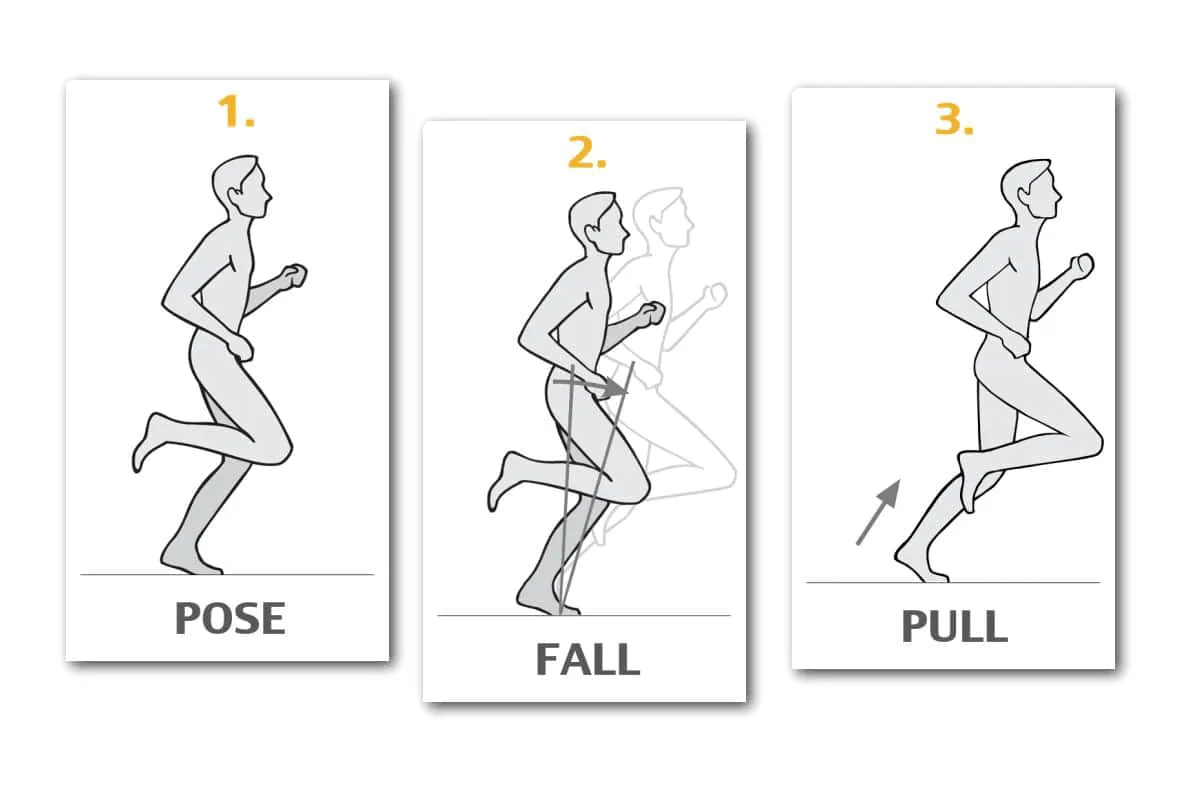Hello, my name is Albert Lu and I'm a local CrossFit coach. I run a CrossFit gym out of my house here in Boise. It's called Audacious CrossFit. And I have a specialty in teaching people how to run.
And today, we're going to go over is the background of what this way of teaching and learning what running is, and it's specifically called Pose Method. And I got my good friend here, Jason, who is a local teacher and CrossFit coach, actually. At his public charter high school in Caldwell.
And he's just going to riff today on what this is all about.
Albert, so you came out to my class while I was on vacation with my family in Ireland. Actually ran my class literally and figuratively through the Pose Method, just talking, teaching them how to run, talking to them about how to run safely.
So you want to describe that process just a little bit for us?
Sure. So Jason asked me to help sub for him for that week. And I literally ran these kids, his weightlifting and his CrossFit kids, through what Pose Method is. It's a systematic way of teaching someone how to run or how to move in relation to the laws of nature or gravity.
So what I took the kids through was to teach them what mechanics was or what the description of what movement running is. And then from there, we applied it in what technique was or technique or the how to do the thing or the run. And it's a simple and elegant way of describing what running is.
We've learned what their specific position, what the body needs to be in, in order to interact with nature or gravity properly. And then from there, do the least amount necessary to get the movement going or running going. And yeah, to emphasize to them that they don't need to do that much in order to run, to get the results they want.
So it was four straight days. You had about 45 minutes of instruction in each class because you had five minutes of changing both ends of the class. But yeah, 45 minutes total times four, which was-- what is that? Three hours total during the week of teaching them how to run and how to apply it in their sports they're actually playing outside of-- CrossFit or Weightlifting.
Yeah, so I work with a lot of young athletes. And I'm a basketball coach, too. And so helping them transfer this to their sport, like how to run safe, how to avoid injuries, overuse injuries, and things like that, especially just with the constant pounding, at least in basketball, up and down the court.
How do you get it to transfer from training to sport?
So it would start with what we did in class was to develop their perception of what their body weight pressure is through their feet. Because when we're running, then we're on the ground. And to develop their perceptions of their feet means they're able to better adjust their technique on the fly if they end up perceiving the wrong pressure, for example, the different part of the feet.
So with that, then, once perception is developed, we could teach them these two concepts. These two concepts are called unweighing and taking advantage of what's called muscle tendon elasticity. And those two things actually help someone run or play their sport more effortlessly, that they don't need to try to use their muscles anymore in order to move or to play the sport.
So we teach them basically from the foundations of those things first, before teaching them straight line running. From there, then we talk about how to change directions. And we change directions by falling in a direction where we want to go. And so they would take those two concepts and better perception of what body weight pressure is and apply it in the change of direction drills.
From there, if they're playing basketball, they're shooting and jumping all the time. So we apply those two same concepts to jumping and shooting as well.
Can you talk a little more about the unweighing?
So you and I are-- we're doing coach speak right now.
Yes, yes.
But as a teacher and a coach, I know sometimes you've got to break these concepts down for kids in more digestible ways.
So how would you take those concepts that we know really well and help a kid really understand what it is that we're looking for? What do we want to see from them?
Gotcha. So what I would do with the kids is take them back to a little basic physics.
So knowing that us as humans on this Earth exist because of this thing called gravity, that when we're on the ground, we're being pulled to the center of Earth by gravity, that means we're balanced on support. And we have a certain body weight at that point.
If we're not on the ground, then we are in the air. And we do not have any weight or any body weight. So that means we're weightless.
So the point is, when we're moving, is to remove our body weight from the ground or support. And we do that by unweighing. Now, the application of this in movement and coaching or having a kid do this is we're trying to take the least loaded part of our bodies, which are the shoulders and the arms and head, and removing it from the ground.
So we're going to take our shoulders and literally shrug up and arms rise up above our heads in order to pull the rest of our body away from the ground.
A good analogy is we're going to tell the kid to imagine that they're slinky. And we're going to take the top part of the slinky and pull it away from the rest of the slinky. And at some point, when we pull hard enough or tall enough or high enough, the rest of the slinky will follow. And that's what we're trying to do when we're unweighing ourselves.
You mentioned jumping. So I know in CrossFit, we do a lot of plyometrics and things like that. Also, as a basketball coach, teaching proper jump mechanics for that sport in particular.
So I like the concept of the slinky. I'm sure that that applies to jumping as well, jump mechanics. Can you talk a little bit about that?
As far as it pertains to running, so we're going to teach someone to get to the specific body position or running pose. And then we're going to fall from support and then pull our feet from the ground. That applies to jumping as well. So we're going to put ourselves in the optimal position in order to respond or to interact with that gravity or that nature.
So we're going to put ourselves in a hinge position, like the bottom of a kettlebell swing, for example. We're going to load our hips and hammies. And then we're going to unweigh using our shoulders and arms to get hip extension. And then we'll get in the air.
As far as that goes, then, yeah, we're going from that pose of the hinge to the pose of-- essentially, in the air and landing back on the ground in that same hinge position again. And then as far as reacting or responding with the ground when we finally get on the ground, in order to continue that movement and not stop movement and to continue jumping, we can take advantage of that muscle tendon elasticity that exists in our bodies.
So that springiness or recoil action happens in our muscle tendons for interacting with the ground quickly.
OK. I know you talk a lot about the pull when you're running. And that order of muscle activation is super important. Lately, I've been seeing things even in relationship to jumping where people are really working their anterior tibialis, tib raises, those kind of things. And there seems to be an emphasis on those pulling muscles. And not just because the other muscles aren't working, but just the order in which they come online and things like that. So maybe I want to talk about that a little bit.
I think what I would like to go back to is Newton's laws of motion.
So Newton's got three laws of motion. And the first law of motion states an object at rest stays at rest, or an object in motion stays in motion unless an unbalanced or external force acts upon it. And what we need to look at is the different actions and movements we're taking in our lives in sports. They're actions we take in order to get some result we want. And we need to consider is these forces that we're using, shouldn't it be focused on the internal forces or muscles? We should be acting based on these external forces or gravity.
So when we're cueing someone as a coach, we need to have them think, do that action, jump, or to throw, or do a clean or something. We're telling them to do the action and let the muscles respond accordingly to the demand that they're putting the bodies under.
Now when talking about running then. It's the pull action that we're cueing someone to do. We're just trying to tell them to break contact with the ground.
So as soon as that foot comes to the ground, we're thinking immediately get it up off the ground again. And the muscles that are causing that to happen are just those. Those pulling muscles, yeah.
For a lot of people who are ignorant or haven't been trained this way yet, they're going to feel their hamstrings work a little more than before. Makes sense.
Yeah, that makes sense.
So it sounds to me like I've been looking a lot into constraints-based coaching, especially when you're cueing your athletes to do certain things. Really, you're putting them in an environment where you're teaching them to interact with their environment. Because in sport, the environment is constantly changing. We're throwing lots of variables in there and they have to be able to respond to those variables.
So it sounds like this is a little bit like constraints-based approach. I mean, can we talk about that a little bit? or is that kind of off topic.
I don't think we veered off the tracks too much. I would just consider as you're imparting some scenarios on the kid or the athlete and then having them play in that game of that scenario and respond accordingly to what you want them to do, right? Now, it's, yes, giving them the concept of the standard of what movement is, knowing that they need to get to the certain body position, they need to shift their body, their center of mass in a direction where they want to go and then change support.
So they change support by essentially pulling their feet off the ground. So in that specific scenario or drill or play, having them apply that technique to, in the middle of the sport skill they're trying to apply.
So if we have some type of baseline training of knowing what body position, what shifting that mass is and what change of support is as a baseline, they can, if they have it automatic, then they can also automatically apply into their sport of choice.
I would say, going back to what Pose Method is, right? We're teaching movements via, teaching them via a bunch of poses. So we're changing from pose to pose to pose and whatever movement we're doing. And we teach them that starting with a certain key pose. For example, we're teaching some how to deadlift. Then what's the starting position of a deadlift?
So there. And then from there, we unweigh, and we change poses. We stand up with the weight. We achieve that final pose, essentially, right? And if we can teach all our movements, especially in CrossFit that way, we're looking at the lens of pose to pose to pose.
And knowing where our center of mass or every interaction of gravity is that way, it changes the game completely. Their stamina might be a little more increased because of that, for example. Rowing too. When you're on the rower and in the starting position of rowing, when you start driving out, right? maybe consider falling backwards away from that platform where your feet are on instead of driving off with your muscles so hard.
So, oh, that all applies, getting our center of mass moving in the direction we wanna go. And again, not try to do, exert effort on the eccentric or concentrics or holding an isometric too long. We're trying to get them to redirect movement and not stop movement. That's huge when you talk about agility and those things that are necessary for sport or to be successful at the sport, making it look easy.
So Pose Method transcends running. It's not just running, it's all movement because we're looking at when a body's on the ground to when it's in the air. I'm just trying to figure out how well can you get into the air and stay in the air as long as you can, essentially. Well, I think that that would make sense to coaches who emphasize movement patterns over exercises.
I have kids that come in like, when are we deadlifting? I'm like, do you mean when are we gonna hinge again? Or, you know, I talked to them about the exercise is less important than the movement pattern that we're trying to train. Like, you know, I can make you stronger at a bench press without bench pressing, you know, all the time.
And you mentioned the wall ball shot that made me think of even, like you and I have worked a little bit in Olympic weightlifting. I think we took a level two together, level one, something. From a coach who is great. And think about that kind of falling underneath the barbell. On the catch, in order for that to happen, you've got to disconnect from the ground a little bit, right? So I totally get that. That's awesome.
Now, who are you looking to help, you know, outside of the people who come in and out of your gym or helping out a friend? Like, I mean, where do you see venturing out with this methodology?
So I would rewind back to 2017, I moved up here, that when I came up, I knew I wasn't the, I was the only certified Pose Method running technique specialist out here. And I was gonna carve out my niche. That was gonna help out as many communities as I can around here with their movement slash, or under that, running, that nobody was teaching it this way.
And I was gonna reach out to, I did reach out to a lot of PTs, a lot of chiros, sport coaches, crossfit gyms, other gyms, running shoe stores, running clubs, to say, hey, I have this specialty and let me help you personally first, these individuals, but also your patients and clients out, that we can greatly improve their performances as well as reduce their chances of pain and injury, based on just giving an idea of what the standard is, of what movement is, what running is.
I've been asked by Dr. Roman to join him on the road. To go to different army posts to teach soldiers how to run. Problem is, it was identified, I think right before 2020, that it was $557 million every year that just the army is paying for in medical cost, dealing with lower limb MSK injuries. These are mostly soft tissue injuries. Maybe some shin splints and stress fractures that they're lumped in, right? That is also resulting in 8.8 million lost duty days per year. That these, specifically army soldiers, cannot do their job because they're put on medical profile. And in the event that they should be called to deploy and fight for us, they can't.
Now, with that problem defined, then the solution has been that in 2020, Army put in Pose Method as their method of instruction of running skill to those soldiers. So there's something called the Holistic Health and Fitness Field Manual. This is a 7-22. And specifically in that manual of chapter seven, it's literally called running skill. So now soldiers can refer to that field manual. If they need to improve their two mile run, for example, as part of their ACFT, their Army Combat Fitness Tests, they can look at those series of drills and exercises and be able to practice it themselves and execute on their runs.
Now the value of that is that someone else can now instruct that. Someone else can follow that and then help someone else in the army itself, like in the field manual and all that. And me as a local resource for them too, to go to them, to show them what these drills actually are and how they're supposed to be executed, what the intent of those are, to give them all that knowledge and to help each other out.
I would say with that then is when we are helping people as far as the CrossFit world goes, right? It just goes down to the very beginning when we took our level one, is that we're preparing people to handle the unknown and unknowable. And as regular people on the street or first responders and military guys, we're all imposed with the same demands, physical demands, really. Just at different levels but yeah, different levels. Yeah, different magnitudes. Right. Yeah. So in terms of those guys who really need to go on and look for people, help people and fight potentially, right? Then their ultimate level skill needs to be at the highest levels, right? For the results for life lost or gained, especially life lost or saved, that they really need to really emphasize this and learn this well. Yeah, for the job or role they're in, I think.
I know with my kids, I mean, they remember the things that you taught them. They talk about it. That's great. So I would definitely encourage people who are listening to reach out to you and whether they're a sports coach or physical education teacher or anybody who just wants to bring in an outside just speaker. I know you talked to my health class too. Yeah. And I know as a teacher, it's nice to bring in somebody from the outside to just, you know, they get tired of listening to you all the time. I mean, me as a teacher, so I think that that's great. Anything else? I think that's it.



